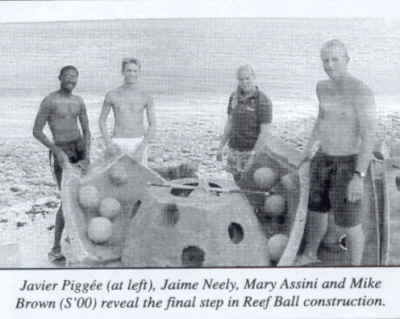
ISLAND NEWS
The Island School, Cape Eleuthera, Bahamas, Summer '00

Artificial Reef Research: Reef Balls
When a hollow dome of concrete is placed in shallow
water what does it do? Sir
Nicholas Nuttall from the Bahamas Reef Environment Educational Foundation
(BREEF) supplied The Island School with the materials and know-how to construct Reef Balls in May of this year.
The group of students studying artificial reefs realized that reef balls were a step
up from their cinder block and conch shell artificial reefs that they studied this
spring. With the smaller homemade reefs in place this past spring, student research clearly demonstrated that an
increase in the structural complexity of the underwater habitat was associated with increased abundance and diversity
of reef fish. This could be an asset to local fishermen and The Bahamas De-
partment of Fisheries.
The reason BREEF is supporting Reef Ball technology at The Island School is that recent developments in marine policy in the Bahamas place reef balls in an ideal position to make a difference. As the Department of Fisheries is educating local communities about the planned Marine No-Take Reserve at Cape Eleuthera, local fisherman are not excited to give up fertile grounds for harvesting conch, crawfish, and reef fish like groupers
and snappers. But Reef Balls, placed outside the proposed reserve area, would provide local fishermen with an alternative catch.
At the same time, Reef Balls placed inside the reserve would encourage fish to remain within an area that is not under fishing pressure. The essential ingredient to gaining further local support, for these ideas is proof. The students conducting research here at The Island School will document the changes in fish populations, coral recruitment, and algae growth on the Reef Ball structures and hope to provide evidence that will help policymakers and residents decide how to best use the tools at hand to keep the marine environment of the Bahamas beautiful for the future.
